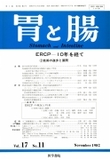Japanese
English
- 有料閲覧
- Abstract 文献概要
- 1ページ目 Look Inside
急性閉塞性化膿性胆管炎(acute obstructive suppurative cholangitis,以下AOSC)は,原因のほとんどが総胆管結石の嵌頓であるにもかかわらず,その死亡率は保存的治療で100%,手術的胆道ドレナージで25~88%1)~13),経皮経肝胆道ドレナージでも17%14),42.8%15)と極めて高く,より早急な,侵襲の少ない胆道減圧処置の必要性を示唆している.
近年,筆者らが試みている内視鏡的緊急胆管減圧法は胆管内カニュレーションによる嵌頓結石の突き上げを主体とするもので,当初,内視鏡的乳頭括約筋切開術(以下,EST)後にAOSCを惹起した症例に試み劇的な効果を得たことが16),その後ESTの施されていない症例17にまで本法を展開させる動機となった.本稿ではAOSC12症例を対象に,内視鏡的緊急胆管減圧法の具体的手技と成績を中心に報告し,本法の特徴と臨床的意義につき述べたい.
The high mortality rate reported in previous series of AOSC suggests the need for a quicker and less invasive method for bile duct decompression. Duodenoscopic cannulation is a rather simple yet lifesaving procedure in this respect. Using a No. 7 French stiff teflon catheter (Fig. 1) or a long-tip cutting probe (Fig. 1), 20 patients suspected of having AOSC were treated by emergency bile duct cannulation. All patients presented with abdominal pain, fever and jaundice. Twelve of these had true AOSC, judging from their clinical pictures and the purulent nature of bile (Table 1, 2), and the others acute obstructive cholangitis. Four of the 12 patients with AOSC were in profound shock, including three with mental symptoms.
Under vigorous treatment against shock, the patient was prepared by pharyngeal anesthesia alone. After cannulating the papilla using a JF-1T duodenoscope (Olympus) the teflon catheter or the cutting probe was advanced deep into the bile duct against some resistance posed by an impacted stone. On forcing up the stone, a sudden gush of purulent bile was observed with instant and dramatic relief of the symptoms in all the patients. Aspiration with a syringe facilitated rapid decompression and, if feasible, bile duct irrigation with antibiotics-containing saline was added. The procedure was followed by placement of a nasobiliary drainage catheter in 10 patients with (5 patients) or without (5 patients, including 4 with previous sphincterotomy) sphincterotomy, or by sphincterotomy and basket extraction in one. Serum bilirubin levels and white blood cell counts promptly decreased after these maneuvers (Fig. 8, 9).
Since no sufficient information as to the number and size of the stones or ductal anatomy is available in most cases in such an emergency state, or since AOSC may be associated with coagulation deficits, one should not insist to perform sphincterotomy and/ or basket extraction; rather, bile duct decompression alone must be made with no delay. Even when the patient's condition permits one to carry out sphincterotomy, it should preferably be confined to a medium-size incision only enough to facilitate drainage and indwelling catheter placement.
When compared with nonoperative treatment of AOSC by the percutaneous transhepatic route reportedly associated with an improved mortality, the endoscopic procedure has several distinct advantages: (1) more effective decompression can be attained by downstream drainage; (2) it is easy to perform especially in cases with previous sphincterotomy or spincteroplasty; (3) it is feasible even in the presence of hemorrhagic diathesis; (4) since no radiologic visualization of the biliary tract is required, an increase in the bile duct pressure which may precipitate shock can be avoided; (5) it does not impose the risk of bloodstream infection through a traumatic cholangiovenous shunt; and (6) bile duct decompression by dislodgement of the impacted stone followed by aspiration of purulent bile, intraductal irrigation and placement of a continuous drainage catheter can be done in sequence as a one-step method. On the other hand, some disadvantages exist. It requires an experienced hand at ERCP and EST, and is not feasible in patients whose papilla does not allow endoscopic access. In some patients, it may be difficult to determine whether stone impaction is in fact the cause of AOSC. Meticulous history taking is essential and echographic examinations would be of great help. Even if there are no definitive findings suggesting the presence of stones, the high incidence of stone reported in the previous series and the condition justify an early attempt of the endoscopic procedure.

Copyright © 1982, Igaku-Shoin Ltd. All rights reserved.


